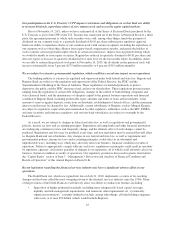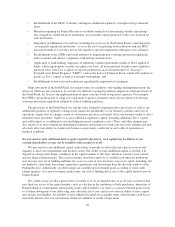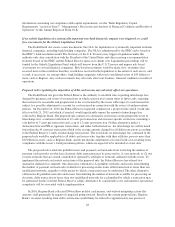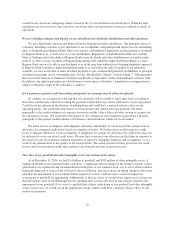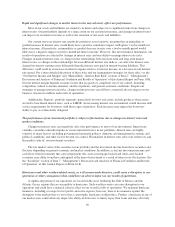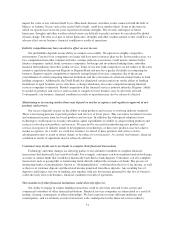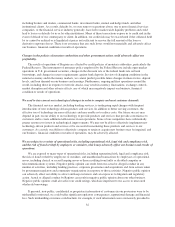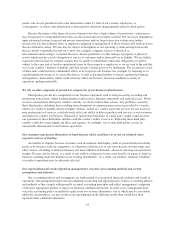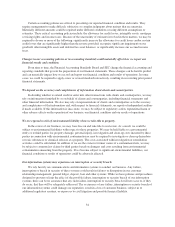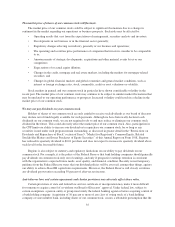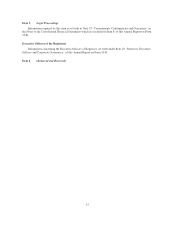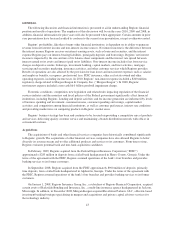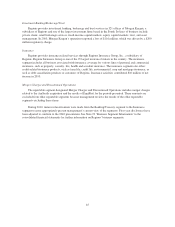Regions Bank 2010 Annual Report Download - page 49
Download and view the complete annual report
Please find page 49 of the 2010 Regions Bank annual report below. You can navigate through the pages in the report by either clicking on the pages listed below, or by using the keyword search tool below to find specific information within the annual report.The market price of shares of our common stock will fluctuate.
The market price of our common stock could be subject to significant fluctuations due to a change in
sentiment in the market regarding our operations or business prospects. Such risks may be affected by:
• Operating results that vary from the expectations of management, securities analysts and investors;
• Developments in our business or in the financial sector generally;
• Regulatory changes affecting our industry generally or our business and operations;
• The operating and securities price performance of companies that investors consider to be comparable
to us;
• Announcements of strategic developments, acquisitions and other material events by us or our
competitors;
• Expectations of or actual equity dilution;
• Changes in the credit, mortgage and real estate markets, including the markets for mortgage-related
securities; and
• Changes in global financial markets and global economies and general market conditions, such as
interest or foreign exchange rates, stock, commodity, credit or asset valuations or volatility.
Stock markets in general and our common stock in particular have shown considerable volatility in the
recent past. The market price of our common stock may continue to be subject to similar market fluctuations that
may be unrelated to our operating performance or prospects. Increased volatility could result in a decline in the
market price of our common stock.
We may not pay dividends on your common stock.
Holders of shares of our common stock are only entitled to receive such dividends as our board of directors
may declare out of funds legally available for such payments. Although we have historically declared cash
dividends on our common stock, we are not required to do so and may reduce or eliminate our common stock
dividend in the future. This could adversely affect the market price of our common stock. Also, participation in
the CPP limits our ability to increase our dividend or to repurchase our common stock for so long as any
securities issued under such program remain outstanding, as discussed in greater detail in the “Restrictions on
Dividends and Repurchase of Stock” section of Item 5. “Market for Registrant’s Common Equity, Related
Stockholder Matters and Issuer Purchases of Equity Securities” of this Annual Report on Form 10-K. Regions
has reduced its quarterly dividend to $0.01 per share and does not expect to increase its quarterly dividend above
such level for the foreseeable future.
Regions is also subject to statutory and regulatory limitations on our ability to pay dividends on our
common stock. For example, it is the policy of the Federal Reserve that bank holding companies should generally
pay dividends on common stock only out of earnings, and only if prospective earnings retention is consistent
with the organization’s expected future needs, asset quality, and financial condition. Recently issued temporary
guidance from the Federal Reserve states that our dividend policies will be assessed, among other things, against
our ability to achieve Basel III capital ratio requirements. Moreover, the Federal Reserve will closely scrutinize
any dividend payout ratios exceeding 30 percent of after-tax net income.
Anti-takeover laws and certain agreements and charter provisions may adversely affect share value.
Certain provisions of state and federal law and our certificate of incorporation may make it more difficult
for someone to acquire control of us without our Board of Directors’ approval. Under federal law, subject to
certain exemptions, a person, entity or group must notify the federal banking agencies before acquiring control of
a bank holding company. Acquisition of 10 percent or more of any class of voting stock of a bank holding
company or state member bank, including shares of our common stock, creates a rebuttable presumption that the
35


